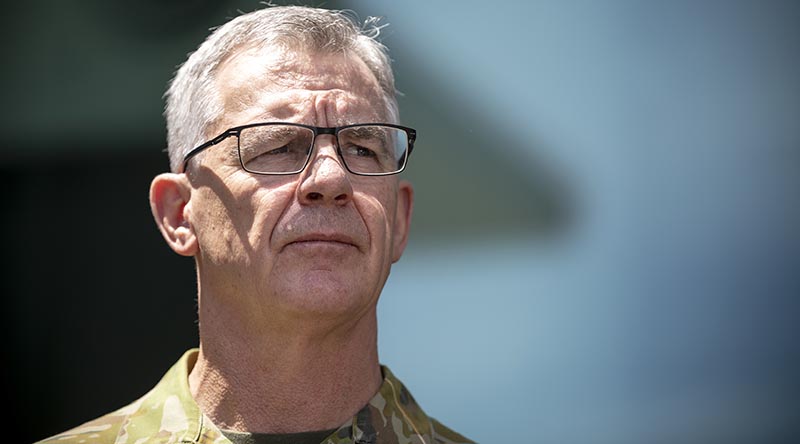Chief of Army outlines ‘sacking’ process after war-crimes report
Share the post "Chief of Army outlines ‘sacking’ process after war-crimes report"

Statement from the Chief of Army Lieutenant General Rick Burr on administrative action in the wake of the IGADF Afghanistan Inquiry Report
[unedited]CAPTION: Chief of Army Lieutenat General Rick Burr fielding media questions at Russell Offices, Canberra. Photo by Lauren Larking.
VIDEO: A rough day at the office, according to this ABC report by Andrew Green…
Let me begin by stating that the welfare of Army’s people is always foremost in our mind.
To set the scene, over 26,000 people served in Afghanistan on Operation Slipper and extraordinary things were achieved by many through their service and sacrifice during Australia’s longest operation.
Last Thursday, the CDF briefed the findings of the IGADF Afghanistan Inquiry Report, which focused on events between 2005 and 2016. As part of the Inquiry, 423 witnesses were interviewed. The CDF accepted all the recommendations of the report and Defence is now developing a comprehensive implementation plan.
On the same day the CDF delivered the findings, I was in Perth and I briefed the SAS Regiment on the report. Commander Special Operations Command did the same in Sydney at the Special Operations Forces Units. In my remarks to the SAS, I said that I would take action in accordance with the report’s recommendations.
There are two processes in relation to this that I would like to explain. One is referral to the Office of the Special Investigator, which the CDF is now considering. Secondly, what I can do within my authority as the Chief of Army to uphold Army’s values and professional standards.
People are aware that this is the process and that this process is underway. Administrative action is a long-standing, well-established process within Defence that ensures the rights of individuals to due process and fair hearing. This process is well-known to all in Army.
At this time, 13 individuals have been issued administrative action notices in relation to the Afghanistan Inquiry. At this point in time, no individuals have been separated from the Australian Defence Force.
Administrative action includes receiving a notice proposing to terminate the individual’s service. The individual then has the opportunity to respond within a minimum of 14 days. The decision-maker must consider any written response that the individuals provide before making a decision. Each matter and individual circumstance will be considered on a case-by-case basis.
It is essential that privacy be respected and that procedural fairness is followed, and that no further comment be made until the process is complete. It is critical that, for any judicial, disciplinary or administrative action, due procedural process must occur. I want to stress the importance of acknowledging and respecting the privacy of individuals, and enabling due process to take its course.
Legal, welfare and command support is provided to anyone who is subject to administrative action. This whole process will take time, and we will do this work methodically, deliberately, and in accordance with established process.
Again, I reiterate my confidence in the Australian Army. We are all committed to learning from the Inquiry and emerging from this a stronger, more capable and effective army. Thank you.
.
.
.
.
.
.

.
.
Share the post "Chief of Army outlines ‘sacking’ process after war-crimes report"






It would appear natural justice is not a concern in regards to the Show Cause Notices.
I would think ones needs to be found guilty first before a show cause.
Was it not around 30 years ago we brought military justice in line with the civil frame work to ensure our soldiers were not traded so differently from normal ideals of justice!!